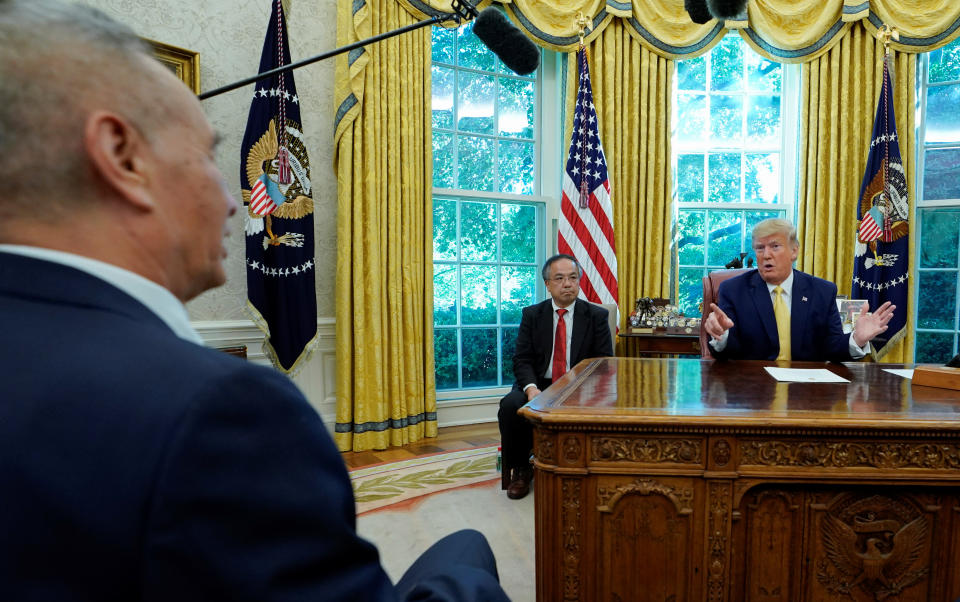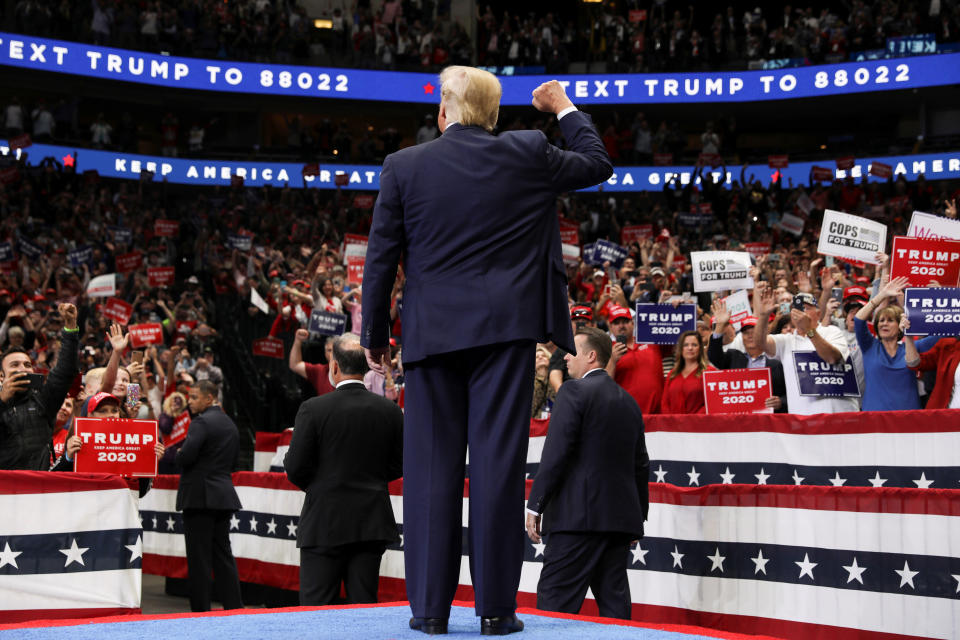Trump made this false claim about China and tariffs at least 108 times in 2019
When President Trump sat before reporters in the Oval Office on Dec. 19 with Rep. Jeff Van Drew, the subject of the trade negotiations with China came up briefly. “They’re still paying tremendous amounts of tariffs,” the president said.
It was a notable comment only for its frequency of use. In fact, according to an analysis by Yahoo Finance, that was at least the 108th instance in 2019 that Trump falsely claimed China is “eating” or “being charged” or in some way “paying” for the tariffs his administration has imposed on Chinese imports.
Trump’s claim has been debunked by fact checkers again and again and again and again. Here’s how FactCheck.org put it: “Not true. The tariffs are taxes paid by U.S. importers in the form of customs duties, and to some extent by U.S. consumers in the form of higher prices.” Politifact said Trump’s claims that China is paying tariffs and that the money is being passed to farmers “simply does not reflect how tariffs work.” (Chinese exporters do bear some of the cost of U.S. tariffs in various ways: they are sometimes forced to offer U.S. importers a discount to help defray the costs of higher U.S. tariffs.)
Yet the criticism hasn’t slowed him down. The first 2019 instance was Jan. 3. In what appears to be his first public comment on China in 2019, Trump tweeted"The United States Treasury has taken in MANY billions of dollars from the Tariffs we are charging China.” Almost 10 months later, it was a nearly identical refrain during a Cabinet meeting: “We’re taking in billions and billions of dollars in tariffs from China,” he said on Oct. 21.
All told, he has made the false claim at least 16 times via tweet, 14 times in media interviews and 78 times during public speeches or in comments to reporters. In one form or another, the president has made the claim about once every three and a half days.
A range of false claims
The tariffs did hurt the Chinese economy — perhaps as much or even more than they hurt the U.S. economy but both economies were impacted by the ongoing trade war. A recent U.N. study showed the ongoing trade war is “hurting both countries” by cutting the U.S. import of Chinese goods by more than a quarter and also driving up prices for American consumers.
The president also often embellishes with additional false details. Recently, he said on Fox News about the tariffs, “it hasn’t cost us anything.” Earlier this year, the Federal Reserve Bank of New York estimated that the cost of the China tariffs is $831 per U.S. household. JPMorgan Chase estimated costs of the tariffs at more than $1,000 per year for the typical American household.

The president has also claimed that the tariffs on China are new. Here’s how he put it in June: “Just so you know, China has been paying us billions and billions of dollars. Until I got here, they never paid this country 10 cents.” In fact, as FactCheck.org demonstrated in a chart using data from the U.S. International Trade Commission, there was, indeed, a spike in tariffs in 2019, but the U.S. collected billions in import duties from China throughout President Obama’s term. Tariffs have been a tool used by the U.S. government for hundreds of years. The Tariff Act of 1789 was one of the first pieces of legislation passed after the ratification of the United States Constitution. It was aimed at European nations but applied to all foreign ships.
Trump’s argument, on the occasions he’s offered one, has shifted over the course of 2019 and has relied on a link where the Chinese government is — in the end — footing the bill on the duties collected by U.S. Customs and Border Protection agents when goods reach a U.S. port of entry.
Things are going along very well with China. They are paying us Tens of Billions of Dollars, made possible by their monetary devaluations and pumping in massive amounts of cash to keep their system going. So far our consumer is paying nothing - and no inflation. No help from Fed!
— Donald J. Trump (@realDonaldTrump) August 3, 2019
In the first months of 2019, the argument was usually that China was “subsidizing” the businesses paying the tariffs. In May, the president said, “China came out, and, in subsidizing the business, they pay for a big portion of that tax.” The argument shifted in June to focus on currency manipulation. “Don't let anyone tell you that we're paying,” he said in a Fox Business interview in June. “We're not paying, China's paying for it. China has devalued their currency in order to pay for it.” Since he began making the currency manipulation argument, Trump's use of the claim has jumped dramatically. In the first four months of 2019, he said China was paying for the tariffs just 15 times. In the ensuing six months — from May to October — he said it at least 79 times.
“People don't understand tariffs, but I understand them,” he told ABC News in June.
Peter Navarro, one of Trump’s closest advisers on the subject, made a version of the argument during an appearance on Yahoo Finance in September. “China is paying the full burden of these tariffs,” he said on Yahoo Finance’s “The Final Round.” “If you put a 15% tariff on China and they devalue their currency by 15%, you don't get a lot of shifting to consumers. Plus, there's no sign of inflation in the data,” he said, referring to U.S. inflation levels which have stayed under 2% in 2019.
Rare acknowledgement of costs to Americans
The president, though, has added some nuance on occasion and acknowledged the financial burden shouldered by American consumers.
On Aug. 13, while discussing plan to wait on some tariffs until Dec. 15, Trump said “we’re doing this for Christmas season, just in case some of the tariffs would have an impact on U.S. customers, which, so far, they’ve had virtually none.” He then immediately added that “the only impact has been that we’ve collected almost $60 billion from China — compliments of China.”

Trump has also sometimes noted that it is U.S. companies that pay the tariffs, saying “China” is being charged. During a Fox interview in May, he said, “Many of these companies that are paying the tariff are moving to Vietnam and other places in Asia. ... We are going to be taking in possibly $100 billion, possibly more than that in tariffs. We never took in 10 cents from China.”
In January, he was discussing his 25% tariffs on certain Chinese imports, when he said, “Out of the 25 points, we are paying for four points out of the 25.” Referring to China, he said, “They’re paying for 21.”
In December, as part of a “phase 1” deal that has yet to be signed, Trump did sign off on cancelling an array of tariffs that were scheduled to go into effect on Dec. 15 on about $160 billion of consumer goods.
“The Penalty Tariffs set for December 15th will not be charged because of the fact that we made the deal,” the president said in announcing the deal on Twitter.
Methodology
Yahoo Finance analyzed over 290 of Trump’s public remarks on China and tariffs throughout 2019, including speeches, press conferences, tweets, media interviews, and campaign rallies. The president’s statements from 2018 were not analyzed although he made the false claim multiple times that year.
Yahoo Finance only used examples of when Trump said that China "is paying, "pays,” is "eating,” is being "charged," or that we "take" tariffs or they are "coming in" from China. A few instances where the president said the tariff money is "compliments of China" were also included. Yahoo Finance did not include multiple instances when Trump said the U.S. is taking in “billions” from tariffs without specifying China as the source.
Oftentimes, he made the claim multiple times within a single set of remarks. That was only counted as a single instance in the total count.
Below is a full month-by month breakdown:
He made the claim at least 6 times in January: Jan. 3, 4, 23, 24, 30, and 31.
He made the claim at least 6 times in February: Feb. 5, 11, 12, 15, 16, and 25.
He made the claim at least 3 times in March: March 3, 13, and 20.
He does not appear to have made the claim in April.
Things picked up in May with at least 13 instances of the claim: May 1, 3, 5, 8, 9, 10, 11, 12, 13, 17, 23, and 27.
He made the claim at least 17 times in June: June 5, 6, 10, 11, 11 (for a second time), 12, 14, 16, 18, 22, 24, 26, 26 (again), and a total of four times on June 29.
He made the claim at least 14 times in July: July 1, 1 (for a second time), 5, 7, 12, 12 (again), 15, 16, 17, 19, 22, 23, 26, and 30.
He made the claim at least 17 times in August: Aug. 1, 1 (for a second time), 2, 3, 5, 9, 13, 14, 15, 15 (again), 18, 18 (again), 23, 25, 26, 26, and 30
He made the claim at least 11 times in September on: Sept. 1, 4, 6, 6, 9, 13, 16, 20, 20, 20, and 25.
He made the claim at least 7 times in October on: Oct. 6, 7, 9, 16, 17, 21, and 21.
He made the claim at least 10 times in November on: Nov. 1, 4, 6, 8, 9, 12, 14, 17, 19, and 22.
He made the claim at least 4 times in December on: Dec. 3, 3 (for a second time), 18, and 19.
This story was updated on Dec. 26 to reflect new instances of Trump making the claim.
Ben Werschkul is a producer for Yahoo Finance in Washington, DC. Sarah Paynter contributed additional reporting.
Read more:
Trump: Stocks would be 25% higher if the Fed had not raised rates
Trump: 'We have ended the war on American Workers'
Navarro says Trump will not roll back tariffs for phase one trade deal with China
China signals US only needs to remove part of the tariffs for a trade deal
Read the latest financial and business news from Yahoo Finance
Follow Yahoo Finance on Twitter, Facebook, Instagram, Flipboard, LinkedIn, YouTube, and reddit.



